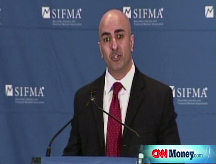FDIC nears IndyMac sale
As a sale of the most expensive bank failure in history - estimated at $9 billion - nears, it is now dwarfed by the trillions in other bailouts.
NEW YORK (CNNMoney.com) -- The final chapter is close to being written on IndyMac, the California thrift that rose high on the risky mortgages that fueled the housing boom before collapsing in the most expensive bank failure in U.S. history.
The Federal Deposit Insurance Corp., which has been running the bank since early July, is reportedly close to finding a buyer for its remaining shriveled assets. The shock that the bank's failure caused in July has been muted by the trillions committed by the government in other failure bailouts, supporting institutions that dwarf IndyMac in size and influence.
The FDIC now estimates it will spend about $8.9 billion protecting the deposits of IndyMac's customers, although the final cost to its $35 billion insurance fund will depend upon how much it gets for the bank's remaining assets.
The American Banker and Los Angeles Times both report a deal could come any day and the FDIC now says that it expects a sale by the end of the year. No one from the bank was available for a comment on Wednesday.
IndyMac became one of the leading home lenders in the country by specializing in questionable Alt. A mortgages, loans that did not require borrowers to provide full or even any documentation of their income.
IndyMac was able to take those loans and sell them to investors eager to buy securities backed by loans that paid higher interest rates than traditional mortgages. These loans helped fuel the boom in home sales and home prices, by making money available to potential buyers who couldn't buy homes in the past. Many times Alt. A mortgages, also known as liar's loans, were used by people buying property for investment purposes rather than as their primary residence.
When home prices were soaring, the loans posed a limited risk to IndyMac or investors, because if a borrower defaulted, the home could be sold for more than was owed. Relatively few of the homes ever went into foreclosure because homeowners who couldn't afford the payments often were able to sell the homes for a profit.
But as home prices started to fall in 2007, the default rates on the loans soared, and investors started to take large losses. IndyMac found it more difficult to sell the loans, and started absorbing losses on the loans.
While critics of Alt. A mortgages had warned of problems for years, IndyMac's problems appeared to come up suddenly. The FDIC did not have it on its watch list at the end of March, even though it had run up $896 million in net losses in the nine months from July 1 2007 through March 31, 2008.
On July 7, the bank announced it was closing its mortgage lending business that had been its backbone, and that it could no longer be considered well capitalized. With depositors withdrawing more than $1 billion in deposits, the FDIC moved to take over the bank on the evening of July 11.
The agency first estimated the failure would cost between $4 billion to $8 billion. It also expected a sale of the bank as a complete entity within 90 days. Both forecasts proved to be far too optimistic.
But the problems at IndyMac were soon overtaken by the fracturing global financial markets which prompted the Treasury Department, Federal Reserve and Congress to commit trillions of dollars to shore up the nation's largest banks and financial institutions.
While IndyMac is still the most expensive bank failure, it is hardly the largest. When Washington Mutual was taken over by the FDIC less than three months later, it had nearly 10 times the assets of IndyMac, although its purchase by JPMorgan Chase (JPM, Fortune 500) protected the FDIC's insurance fund from having to cover any costs. A week later the FDIC moved to facilitate the sale of Wachovia (WB, Fortune 500) to keep that even larger bank from failing as well.
By the end of September, there were 171 banks on the FDIC's list of troubled banks, more than double the 76 on the watch list at the end of 2007. There have been 25 banks failures this year, at a cost to the FDIC fund of $15.6 billion, compared to only three in 2007 that cost the fund a mere $120 million.
The FDIC fund has fallen to $35 billion as of Sept. 30, a level that will fall even further by the end of this year. The agency considers $50 billion the level necessary to be fully funded.
To try to replenish the fund, the FDIC has raised the premiums it charges banks, effective Jan. 1. The healthiest banks will now pay 12 cents for every $100 of insured deposits, up from only 5 cents. The more troubled banks also saw a rise in their premiums, to 50 cents per $100 of deposits from 43 cents.
But the FDIC estimates that even with increased premiums, it will take five years to replenish the fund to sufficient levels. The FDIC does not want to raise premiums too high at a time when the Treasury Department and Federal Reserve are scrambling to pump money into the banks in order to spur lending.
All news is bad news in real estate right now. Have you recently bought a house anyway? Send your story and photos to realstories@cnnmoney.com and you could be featured in an upcoming article. ![]()






